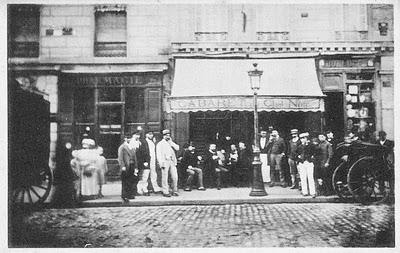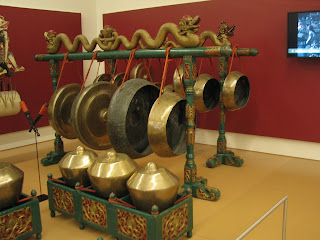Introducing Eric Alfred Leslie Satie (1866 - 1925)
Pianist
Phonometrician
Writer
Playwrite
Artist
Writer
Playwrite
Artist
Dadaist
Surrealist
Film-Maker
Film-Maker
Wit
Dandy
Prankster
Alcoholic
Priest
Recluse
Dandy
Prankster
Alcoholic
Priest
Recluse
Friend of stray dogs
&
Collector of lost Umbrellas
included amongst his working partners were
Musicians, Artists, Poets, Writers, Dancers and Film makers:
Musicians, Artists, Poets, Writers, Dancers and Film makers:
Claude Debussy
Maurice Ravel
Francis Poulenc
Igor Stravinsky
Pablo Picasso
Man Ray
Ramon Casas
André Derain
Marcel Duchamp
Georges Braque
Constantin Brâncuși
Sergei Diaghilev
Léon Bakst
Georges Braque
Constantin Brâncuși
Guillaume Apollinaire
Patrice ContamineSergei Diaghilev
Léon Bakst
The Ballet Russe
Jean Cocteau
Leonid Massine
&
Gertrude Stein
&
Gertrude Stein
he is known to have loved only one girl, Suzanne Valodon
An artist who painted his portrait in 1892
Erik Satie painted by S Valodon (1892)
she also modelled for pictures by Renoir,
Suzanne Valodon painted by Renoir
Degas
Suzanne Valodon painted by Degas
and Toulouse Lautrec
Suzanne Valodon painted by Toulouse Lautrec
Alas
Suzanne Valodon
broke Satie's heart after which he always lived alone as recluse
The Early Years
Éric Alfred Leslie Satie was
born in 1866, he had a younger brother called Conrad. At the age of
six his family life came to an abrupt and tragic end after his English
born mother suddenly died.
His father, a translator in Paris, sent the two children to be looked after by their grandparents who were living in the pretty seaside town of Harfleur, Normandy, a port on the banks of the estuary of the Siene. The house where they lived has been made into a museum commemorating Satie's life.
His father, a translator in Paris, sent the two children to be looked after by their grandparents who were living in the pretty seaside town of Harfleur, Normandy, a port on the banks of the estuary of the Siene. The house where they lived has been made into a museum commemorating Satie's life.
In
1878 his grandmother died, the 12 years old Eric and his younger
brother returned to live with their father in Paris. Satie had had
organ lessens in Harfleur, instead of sending him to school his father enrolled him at the Conservatoire de Paris, but the young Satie, by now 13 years
old, was either unable or unwilling to fit in with the academic
surroundings. His teachers reported that he was "gifted but indolent",
"worthless" and one commented he was "the laziest student in the
Conservatoire".
 |
| Conservatoire de Paris |
But they were wrong, Satie was gifted and loved music passionately. Satie refused to suppress his individualism; his
first piece at the Conservatoire, for the piano, was nine bars long, most of it
a quote from a music-hall song called 'Ma Normandie". At home he was
publishing salon compositions written together with his step-mother, a piano
teacher.
His five year brush with the musical establishment
left him dispirited. Aged 19 he enrolled in the army, it was a choice he
immediately regretted, so much so that he purposely sat all night in
the cold in order to make himself so ill that he was discharged. He went
back to Paris to live with his father, one wonders if he had any idea what he
was going to do with his failing life.
Le Chat Noir
After a few months recuperating from pneumonia Eric was
at last ready to take control of his life, he took independent lodgings and
became a young man who was a ready match with the exuberant Parisian lifestyle.
In the 1880s the city became a cauldron for misfits and anti-establishment art lovers, not least amongst them was an outrageous oddball called Rodolphe Salis; a self-centred, rude and theatrical impresario who was doing a roaring trade at Le Chat Noir in the Bohemian Montmatre district of Paris.
 |
| Rodolphe Salis 1851 –1897 |
In the 1880s the city became a cauldron for misfits and anti-establishment art lovers, not least amongst them was an outrageous oddball called Rodolphe Salis; a self-centred, rude and theatrical impresario who was doing a roaring trade at Le Chat Noir in the Bohemian Montmatre district of Paris.
 |
| Rodolphe Salis 1851 –1897 |
Le Chat Noir, which had started life in seedy premises, is credited as being the worlds first "cabaret" bar.
In the lush new premises any artist could perform on stage, and the audience gave immediate feedback in the form of roaring boos or cheers. Le Chat Noir attracted artists, poets, actors, singers and musicians and nourished outrageous new movements like the Salon des Arts Incohérents (Salon of Incoherent Arts) who used the club to première comic acts and experimental theatre.
The club even had its own journal promoting the Arts.
Bohemians and Avant-garde artists flocked from all over the world to meet and rub shoulders with their rich clients
Salis, as conférencier, introduced the acts whilst at the same time delighting
his audience by bullying and insulting customers he had decided to
humiliate;
to one new customer who had obviously arrived with
his wife he exclaimed "What have you done with your chick from
yesterday" and on another occasion when the future King Edward VII
arrived he shouted to the crowds "Well look here: it looks as if the
Prince of Wales is all pissed".
The young out of work Satie replied "I am a Gymnopedist".
This is a word Salis would not have understood because it is the name of an obscure group of nude male dancers who lived in ancient Greece. Afterwards Satie built on the witticism by calling himself "phonometrician," meaning "someone who measures and writes down sounds". Like everything Satie did, his jokes and titles for his music were laced with invention, seriousness and passion, a quality that he developed into an ever more subtle view of the world.
.
Guests would be met at the door by a Swiss guard holding
a Halberd, bedecked and covered from head to foot in gold, whose job it was to bring in the painters and
poets and bar the "infamous priests and the military"
Inside guests sat at tables and were entertained to
piano music and a variety of shows on stage. The club was instant hit and
was adopted as a watering hole for Les Hydropathes, a group of radical young writers,
poets and artists who said they were "afraid of water".
Within three years the club had outgrown its premisies and moved in
torch light procession across Paris to more spacious residence at 84
Boulevard Rochechouart, in Montmartre.
 |
| New Premises, 84 Boulevard Rochechouart . |
In the lush new premises any artist could perform on stage, and the audience gave immediate feedback in the form of roaring boos or cheers. Le Chat Noir attracted artists, poets, actors, singers and musicians and nourished outrageous new movements like the Salon des Arts Incohérents (Salon of Incoherent Arts) who used the club to première comic acts and experimental theatre.
The club even had its own journal promoting the Arts.
Bohemians and Avant-garde artists flocked from all over the world to meet and rub shoulders with their rich clients
 |
| Rodolphe Salis entertaining the customers |
The story
goes that when Salis tried to humiliate the lowly poverty-stricken Satie with a
sarcastic question "what is your profession?".
This is a word Salis would not have understood because it is the name of an obscure group of nude male dancers who lived in ancient Greece. Afterwards Satie built on the witticism by calling himself "phonometrician," meaning "someone who measures and writes down sounds". Like everything Satie did, his jokes and titles for his music were laced with invention, seriousness and passion, a quality that he developed into an ever more subtle view of the world.
.
A little later Satie was employed as a
pianist at Le Chat Noir (1888-1891). Salis famously underpaid his staff
and treated the performers badly. Satie said he found the work
"degrading" but at least his individualism was being noticed, for the
first time his strange musical compositions were being heard and appreciated by
serious musicians such as Debussy and Ravel who both borrowed his musical inventions for their own compositions. Satie's artistic life had at last been launched and he had began enduring life long friendships with Debussy and
the romantic poet Patrice Contamine.
Les Tois Gymnopédies and Les Gnossiennes
Satie published his first masterpeices, Les Tois Gymnopédies and Les Gnossiennes, whilst he was working at Le Chat Noir.
The first edition Les Gymnopédies were completed in April 1888 and included the poetry of Satie's friend Patrice Contamine
Oblique et coupant l'ombre un torrent éclatant
Ruisselait en flots d'or sur la dalle polie
Où les atomes d'ambre au feu se miroitant
Mêlaient leur sarabande à la gymnopédie
Ruisselait en flots d'or sur la dalle polie
Où les atomes d'ambre au feu se miroitant
Mêlaient leur sarabande à la gymnopédie
Slanting and shadow-cutting a bursting stream
Trickled in gusts of gold on the shiny flagstone
Where the amber atoms in the fire gleaming
Mingled their sarabande with the gymnopaedia
Trickled in gusts of gold on the shiny flagstone
Where the amber atoms in the fire gleaming
Mingled their sarabande with the gymnopaedia
The melodies of the pieces use deliberate, but mild, dissonances against the harmony, producing a piquant, melancholy effect that matches Satie's instructions which are to play each piece "painfully", "sadly" or "gravely. The pieces have always attracted dancers, in 1922 Constantin Brâncuși designed costumes especially for a performance of Les Tois Gymnopédies
Tonight Mami Usami-Williams will be dancing Les Trois Gymnopédies and Les Gnossiennes to her own choreography. In the first half she will be dancing the Gnossiennes and after the interval she will perform the earlier Gymnopédies.
The Gnossiennes are said to have been inspired after Satie heard an ancient Javanese instrument called the gamalan being played at the Paris Exposition of 1889 .
Satie Gnossiennes sound exotic
because the scales they use are actually built on tritones, which, in
Western theory, are highly dissonant.
 |
| Gamalan, photo: http://www.joanannlansberry.com |
END





















No comments:
Post a Comment